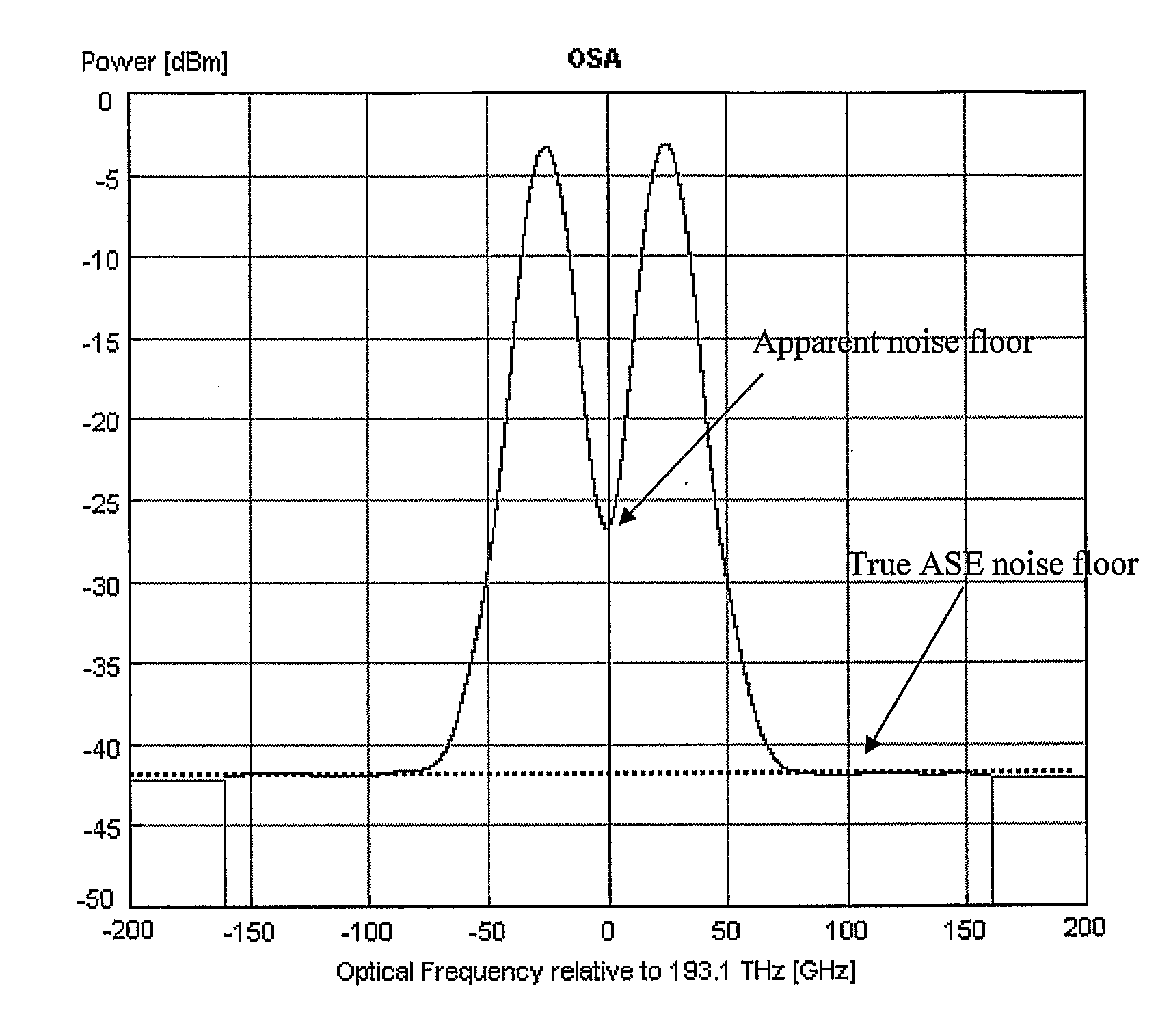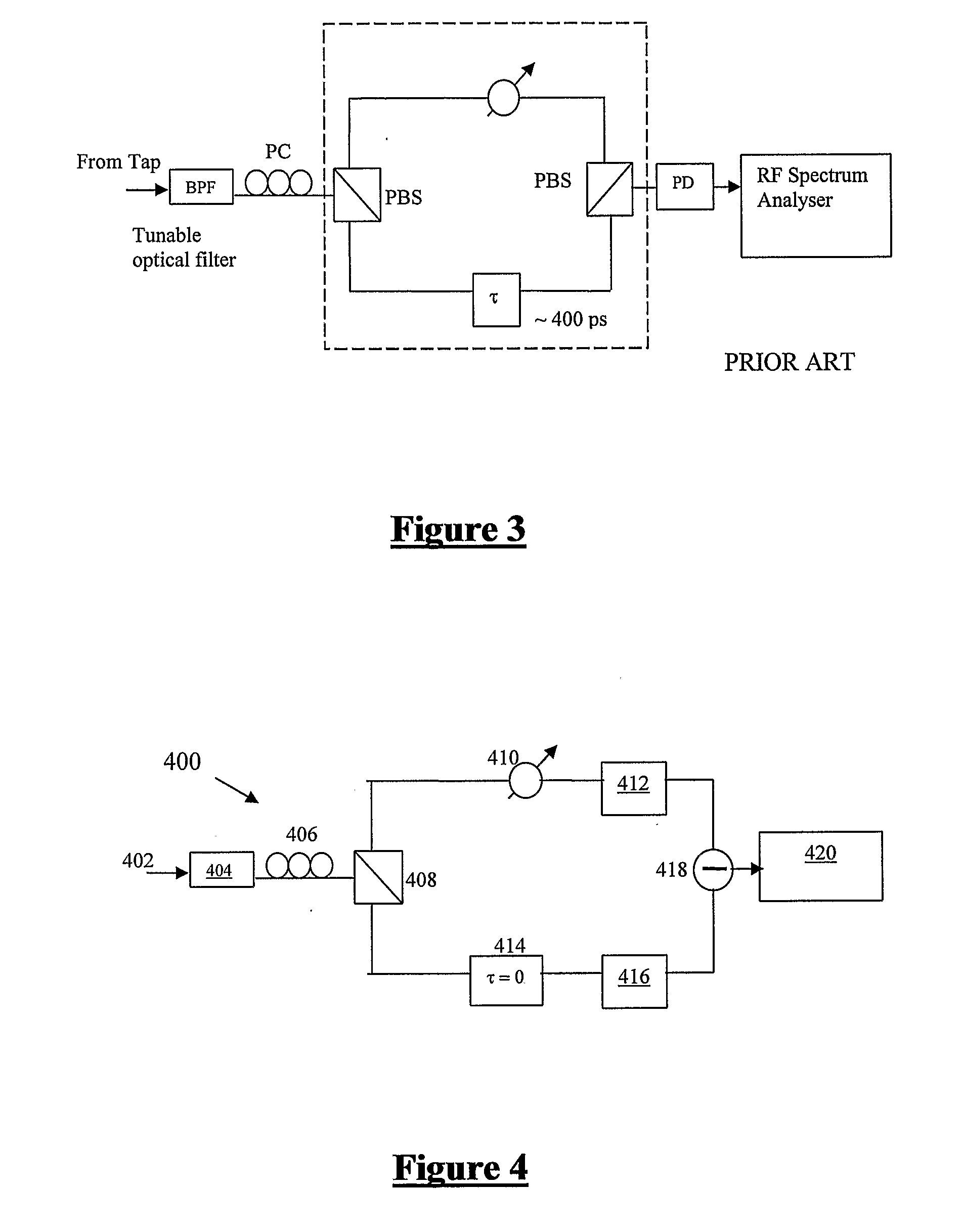Method and Device for In-Band Optical Performance Monitoring
a technology of optical performance monitoring and in-band measurement, applied in the direction of transmission monitoring, electrical equipment, electromagnetic transmission, etc., can solve the problems of osa method failing in reconfigurable networks, reducing the resolution bandwidth of osa will be of no benefit, and osa method failing in wdm systems with high spectral efficiency
- Summary
- Abstract
- Description
- Claims
- Application Information
AI Technical Summary
Benefits of technology
Problems solved by technology
Method used
Image
Examples
first embodiment
[0061]FIG. 4 is a schematic of an OSNR monitoring device 400 in accordance with the present invention. An input optical signal 402 is tapped from a WDM optical network being monitored. The input optical signal 402 is first passed through a tunable optical bandpass filter 404 to ensure only a band of interest is processed. From filter 404, the optical signal is passed through a polarisation controller 406 to orient the polarised data signal at 45 degrees to the input of a polarisation beam splitter 408. Polarisation beam splitter 408 splits the optical signal to produce a first optical signal component and a second optical signal component, which will each carry a substantially equal signal power due to the 45 degree polarisation applied by polarisation controller 406.
[0062]The first optical signal component is passed through a variable optical attenuator 410, and then converted to the electrical domain by photodetector 412 to produce a first electrical signal component. The second o...
second embodiment
[0067]In embodiments of the invention in which cost reduction in respect of the polarisation beam splitter is sought, a low cost polarisation beam splitter with poor extinction ratio (perhaps as low as 3 dB) could be used. Alternatively, FIG. 5 illustrates an OSNR monitoring device 500 in accordance with the present invention, in which the polarisation beam splitter is replaced with a 3 dB coupler, one arm of which is polarised. In considering FIG. 5 in more detail, an input optical signal 502 is tapped from a WDM optical network being monitored. The input optical signal 502 is first passed through a tunable optical bandpass filter 504 to ensure only a band of interest is processed. From filter 504, the optical signal is passed through a polarisation controller 506 to orient the polarised data signal at substantially 45 degrees to the axis of a polariser 512. Power splitter 508 splits the optical signal to produce a first optical signal component and a second optical signal componen...
third embodiment
[0070]It is noted that without polarisation controllers 406, 506 in FIGS. 4 and 5, signal cancellation and noise extraction could not occur at 418, 518 when the polarisation of the input signal 402, 502 is aligned with that of the PBS 408 or polariser 512. FIG. 6 is a schematic of an OSNR monitoring device 600 in accordance with the invention, which builds on the OSNR monitoring device of FIG. 5 by inclusion of a second polariser 632 at substantially 45° to the first polariser 612 to ensure that OSNR can be measured for all input polarisation states, without requiring a polarisation controller at the input. An input optical signal 602 is tapped from a WDM optical network being monitored. The input optical signal 602 is first passed through a tunable optical bandpass filter 604 to ensure only a band of interest is processed. From filter 604, the optical signal is passed to the input of a simple power splitter 608. Power splitter 608 splits the optical signal to produce a first optica...
PUM
 Login to View More
Login to View More Abstract
Description
Claims
Application Information
 Login to View More
Login to View More - R&D
- Intellectual Property
- Life Sciences
- Materials
- Tech Scout
- Unparalleled Data Quality
- Higher Quality Content
- 60% Fewer Hallucinations
Browse by: Latest US Patents, China's latest patents, Technical Efficacy Thesaurus, Application Domain, Technology Topic, Popular Technical Reports.
© 2025 PatSnap. All rights reserved.Legal|Privacy policy|Modern Slavery Act Transparency Statement|Sitemap|About US| Contact US: help@patsnap.com



